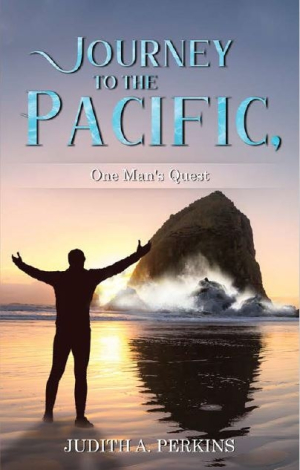It looks like you've stumbled upon a page meant to be read by our code instead of viewed directly. You're probably looking for this page.
Journey to the Pacific
One Man's Quest
In the historical novel Journey to the Pacific, a dreamer influences the growth of his frontier community.
Judith A. Perkins’s historical novel Journey to the Pacific is the story of one man’s dream of seeing the Pacific Ocean and the realities of raising a family in the wild west of nineteenth-century Portland, Oregon.
George—born in the mid-1800s in Illinois—loses his father and brothers in the Civil War. From the age of two onward, he lives in an orphanage, learning independence at a young age. At fifteen, he flees, headed west. His dream is to see the Pacific Ocean.
But complications and adult responsibilities delay George’s travels to the coast. The people he encounters teach him the value of a hard day’s work, the importance of speaking honestly, and persistence. These lessons guide him as he matures, falls in love, becomes a father, and builds a community.
Life on the frontier is described in terms of the challenges that people faced in settling their new territories. These hardships are juxtaposed to instances of tranquil beauty. In time, the once-untouched land transforms; scenes reflect now-bustling city centers as other people travel west too. Former strangers unite, surviving harsh winter storms together and supporting each other’s struggling businesses.
But George’s own story is interrupted by long, distracting peeks into the lives of his extended relatives and some of the people he meets on his journey west. New chapters too often shift to focus on a new person’s perspective and adventures. These secondary storylines dilute the novel with their extraneous details.
The book’s illustrations of how changes and challenges affect people in different ways are also heavy-handed, and some characters are abandoned entirely after having served this purpose. And the book’s dramatic interludes are often too easily resolved—sometimes in the course of a paragraph. Timeline shifts muddle the novel even more, with the story covering weeks and even years with speed, and with different people’s tales occurring at different times. Additionally, the book’s conversations are too formal and stilted in tone, and they’re cramped in appearance on the page; at times, multiple people carry on a conversation that is flowed as a single paragraph. Typographical and agreement errors compromise audience engagement further.
In the historical novel Journey to the Pacific, a dreamer influences the growth of a community in a new territory, inspiring an entire generation.
Reviewed by
Mary McNichol
Disclosure: This article is not an endorsement, but a review. The publisher of this book provided free copies of the book and paid a small fee to have their book reviewed by a professional reviewer. Foreword Reviews and Clarion Reviews make no guarantee that the publisher will receive a positive review. Foreword Magazine, Inc. is disclosing this in accordance with the Federal Trade Commission’s 16 CFR, Part 255.
